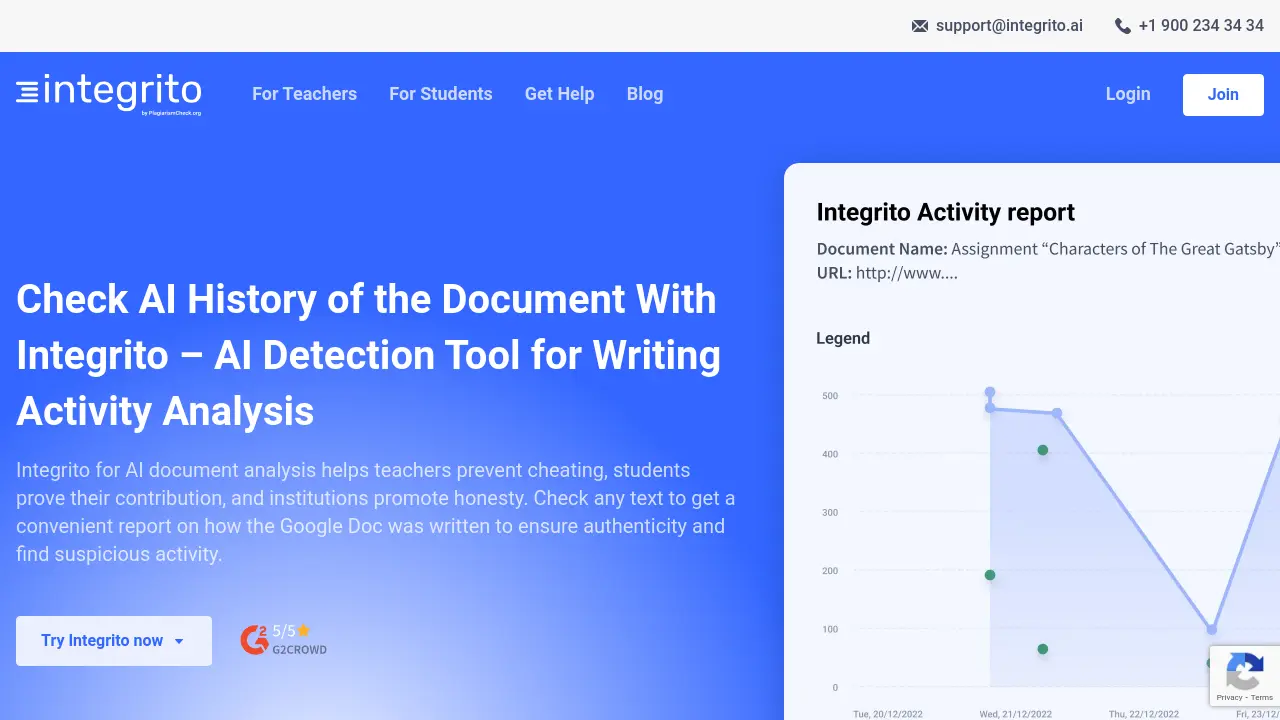Integrito
Check AI History of the Document With Integrito – AI Detection Tool for Writing Activity Analysis

Description
Integrito is an innovative AI detection and text analysis tool designed to promote academic integrity. It provides a comprehensive solution for educators, students, and institutions by analyzing the writing process within Google Docs. This tool helps users understand how a document was created, offering insights beyond simple AI-generated text detection, focusing on the evolution of the written content.
By generating detailed Activity Reports, Integrito allows teachers to identify suspicious writing patterns and prevent cheating, while students can use these reports to substantiate their original work. The tool emphasizes an evidence-based approach, empowering users to make informed decisions about document authenticity by examining the writing journey, including editing time, contribution history, and text evolution, rather than relying solely on AI detection scores.
Key Features
- Google Doc Activity Report: Access a detailed report on how a Google Doc was written, including time spent, writing stages, and contributor analysis.
- Suspicious Activity Detection: Identifies unusual actions such as pasting large chunks of text or multiple undisclosed contributors.
- Writing Process Visualization: Follow the writing process step-by-step and compare each stage to the final version.
- Authorship Verification: Unveils contract-cheating and ghost-writing by showing who contributed to the writing process.
- Integrated Plagiarism and AI Text Detection: Option to apply plagiarism and AI text detection in one click when the Activity Report seems questionable.
- Browser Extensions: Available for Chrome, Firefox, and Edge browsers for easy access within Google Docs.
Use Cases
- Preventing academic cheating by analyzing document creation history in Google Docs.
- Enabling students to prove the authenticity of their work and individual contributions.
- Assisting schools and universities in upholding academic integrity standards.
- Detecting potential contract cheating and ghostwriting by analyzing document contributors and writing patterns.
- Supporting educators in making evidence-based decisions regarding suspicions of AI-generated content.
Frequently Asked Questions
How to interpret Google Docs Integrito Activity Report?
Access the Activity Report to analyze the writing process. Pay attention to the overall time taken, the stages of composing (gradual growth vs. sudden large additions of text), compare various stages with the final version, and identify who contributed to the document.
How to interpret AI Detection results?
Consider AI detection (e.g., 97% accurate as mentioned for associated tools) as a guide. Study flagged parts; large chunks are more suspicious than isolated sentences. Note inconsistencies in writing style. Discuss the work with the student and use the Integrito Activity Report to see how potentially machine-generated parts were created.
What should one do if the Activity Report seems suspicious?
If the Integrito Activity Report raises concerns, consider using plagiarism and AI writing detection. If AI-flagged text appeared suddenly, it's more likely machine-written. Conversely, if the workflow shows gradual development, there's likely no cause for alarm. Always talk to the student about their sources and the paper.
How can students prove their work is original using Integrito?
Students can demonstrate their Integrito Activity Report to their teacher. If the assignment was worked on from scratch, the report will reflect the time spent, the gradual growth of the document, and track progress during each editing session, thereby helping to prove authenticity.
You Might Also Like
Vast.ai
Usage BasedInstant GPU Rentals with Significant Cost Savings
SEATEXT AI
FreemiumAI-Powered Website Optimization for +35% More Conversions
Cliptics
Free100% Free AI Tools - No Signup Required
Callfluent AI
Free TrialAutomate calls with AI phone agents that sound human
InvoiceOCR
PaidInvoice OCR: Fast, Accurate Data Extraction